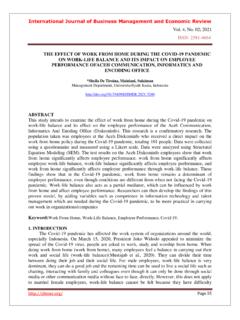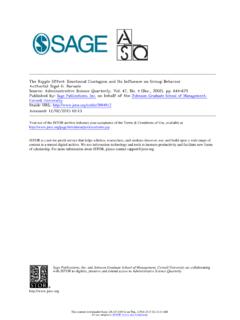Transcription of 1:1 Technology and its Effect on Student Academic …
1 CONTEMPORARY EDUCATIONAL Technology , 2016, 7(4), 368-381 368 One to One Technology and its Effect on Student Academic achievement and motivation Jennifer L. Harris Illinois State University, United States Mohammed T. Al-Bataineh Jordan University of Science and Technology , Jordan Adel Al-Bataineh Illinois State University, United States Abstract This research was a quantitative study using 4th grade participants from a Title 1 elementary school in Central Illinois. This study set out to determine whether one to one Technology (1:1 will be used hereafter) truly impacts and effects the Academic achievement of students . This study s second goal was to determine whether 1:1 Technology also effects Student motivation to learn. Data was gathered from students participating in this study through the Pearson enVision Math series with Topic Tests, Discovery Education Assessment results, and attendance records being used.
2 The results show that 1:1 Technology could be a factor in Student Academic achievement and motivation to be at school. These findings are important due to the technological shift that schools are currently facing. With more Technology exposure for students and more professional development for teachers to hone their newly acquired teaching methods, 1:1 Technology may be the catalyst needed for school districts to help their students achieve at higher levels. Keywords: One to one Technology ; Technology implementation; Student motivation ; Academic achievement . Introduction Since No Child Left Behind s inception, high stakes testing and accountability has beleaguered school districts across the nation. School officials and administrators have tried any and all sorts of remedies to promote Student engagement and success in the classrooms, this includes implementing Technology into curricula.
3 According to the United States Department of Education (2002), the No Child Left Behind Act also sought to eliminate the digital divide and to have Student technologically literate by the end of the eighth grade, regardless of race, socioeconomic status, geographic location, and disability. CONTEMPORARY EDUCATIONAL Technology , 2016, 7(4), 368-381 369 Furthermore, the State of Illinois adopted the Common Core State Standards in 2010, with them being fully implemented in the 2013-2014 school year. These standards have taken the ideals from No Child Left Behind (NCLB) one step further with children as young as Kindergarten aged being computer literate. For example, instead of writing extended response questions, students are expected to type and compose such responses. Current assessment initiatives require school district to use online testing.
4 The new Partnership for Assessment of Readiness for College and Careers (PARCC), which replaces the ISAT Test in the state of Illinois, will be taken online which is a vast difference between old state assessments and new state assessments. These changes are requiring school districts to provide computers and Technology to their students and faculty. The school district participating in this study adopted an initiative for 1:1 Technology to be a part of classrooms in the last few years. This past school year, the school district was able to have select classrooms pilot 1:1 Technology . Teachers at the high school, junior high, and elementary levels were chosen by district administrators to have laptops as a resource and tool for instruction and learning in the classroom. The school district is working closely with local business for this 1:1 initiative to be district-wide in the near future.
5 Due to the State of Illinois continued budget concerns, this is not happening as quickly as it was projected to be. Teachers who are using 1:1 Technology are at an advantage over teachers who do not have this accessibility. 1:1 Technology allows teachers to better and more quickly differentiate, to administer enrichment, and to also dive deeper into topics of study, as the Common Core State Standards puts forth these requirements for students . 1:1 Technology can also motivate students and allow them to be engaged on a completely different level than they have ever before. This study examined whether 1:1 Technology does in fact increase Student Academic achievement and increase motivation in students to learn. One of the main items that No Child Left Behind set out to accomplish was to diminish the digital divide between socioeconomic class and race of students .
6 The school district participating in this study there are two elementary schools that are inundated with higher percentages of low-income students . The majority students do not have the same opportunities to be exposed or have the background or previous knowledge with computing skills and are more often than not, technologically illiterate. Two classrooms from the participating school district were chosen to pilot 1:1 Technology . The hope and goal of this pilot is to see if 1:1 Technology can improve Student Academic achievement in the classroom. This study then took that goal one step further by examining the effects of 1:1 Technology on Student motivation . This study should be useful to legislators, school administrators, and educators as most of our schools are turning to Technology to aid and assist in learning in the classrooms.
7 1:1 Technology is such an asset to any school or classroom. The use of Technology allows teachers to truly differentiate and tailor instruction to meet the needs of their students . With the new Common Core State Standards being implemented and the new appraisal process being fully embraced by the state of Illinois, 1:1 Technology and being technologically literate is such an essential skill for educators, but more importantly, students . This study set out to show how Technology can positively affect Student Academic achievement and motivation in the classroom. CONTEMPORARY EDUCATIONAL Technology , 2016, 7(4), 368-381 370 Literature Review Technology is a recent marvel in our everyday life that has taken off. Technology allows the most difficult tasks to become seamlessly easy and more efficient. In education, Technology has allowed the dissemination of knowledge to be dispersed instantly and it allows for quicker and more effective communication.
8 Also, Technology has allowed students to be engaged and learn in ways that they never have in a classroom setting before. According to Spears (2012) she cites Donovan, Hartley & Strudler (2007) and describes the first 1:1 Technology program that was used in a school setting. Spears (2012) states, The first provider of 1:1 computer access for teachers and students was Apple Classrooms of Tomorrow (ACOT). The goal of ACOT was to promote change in the context of education (p. 1). Spears continues in her study and describes Microsoft s 1:1 initiative through the Anytime Anywhere Learning (AAL) program. Spears (p. 1) cites the work of Donovan et al. (2007), An increase in enthusiasm for teaching and learning with Technology , an improvement in Student writing skills, an increase of authentic and purposeful use of some of the benefits of 1:1 Technology integration programs like the AAL program.
9 These programs in the 1980 s and 1990 s paved the way for presidents, legislators, administrators, and educators to become aware of how positively Technology could impact the Student and teacher in the classroom, alike. The Role of Educational Reform in Technology Development The role of Technology in the world of education has been ever changing. Most recently, Technology has been a new phenomenon to help motivate, differentiate, and allow students to achieve and excel in ways that they have never been able to before. According to Johnson (2003), the computer and Technology , if used correctly, has the ability to invoke dream in the minds of visionary educators who saw endless potential for altering traditional notions of teaching and learning (p. 2). Two past presidents saw the need for fundamental change in education to keep American students in competition with Technology with other students from around the world.
10 In 1994, President Bill Clinton signed The Goals 2000: Educate America Act (Goals 2000: Educate America Act, 1994). There were many parts of this bill that involved Technology and education. Part C of The Goals 2000: Educate America Act, Leadership in Technology , (a) calls upon the Department of Education to create a national strategy to involve Technology into all educational programs and the state and local school systems, (b) foster understanding of how Technology can be used to improve teaching and learning, (c) show how Technology can be used to create an equal opportunity for all students to be successful while meeting state education requirements, and (g) create high-quality professional education opportunities for educators with the ability to integrate Technology into their instruction (Goals 2000: Educate America Act, 1994). After President Bill Clinton signed this bill into action, President George W.

















